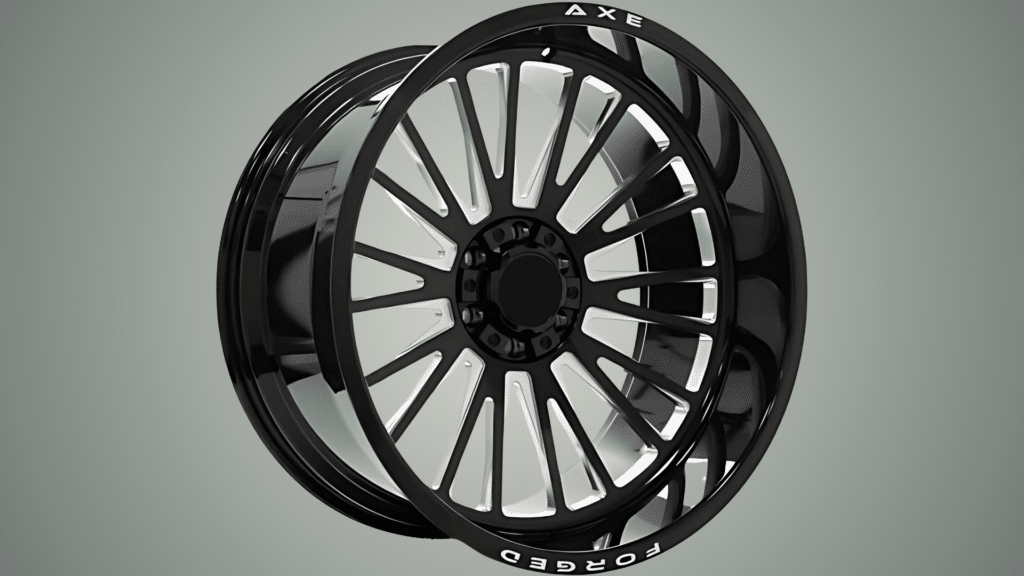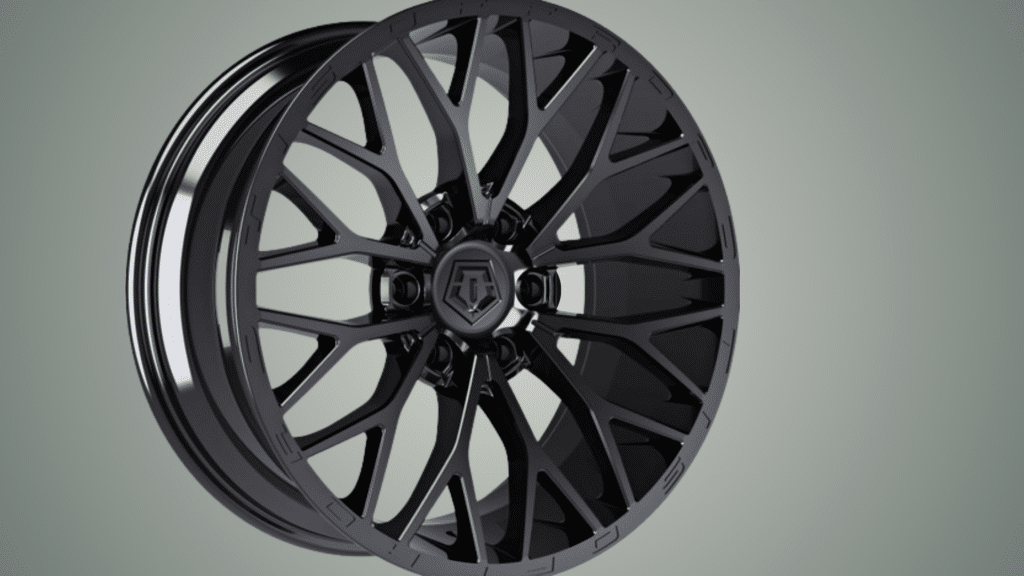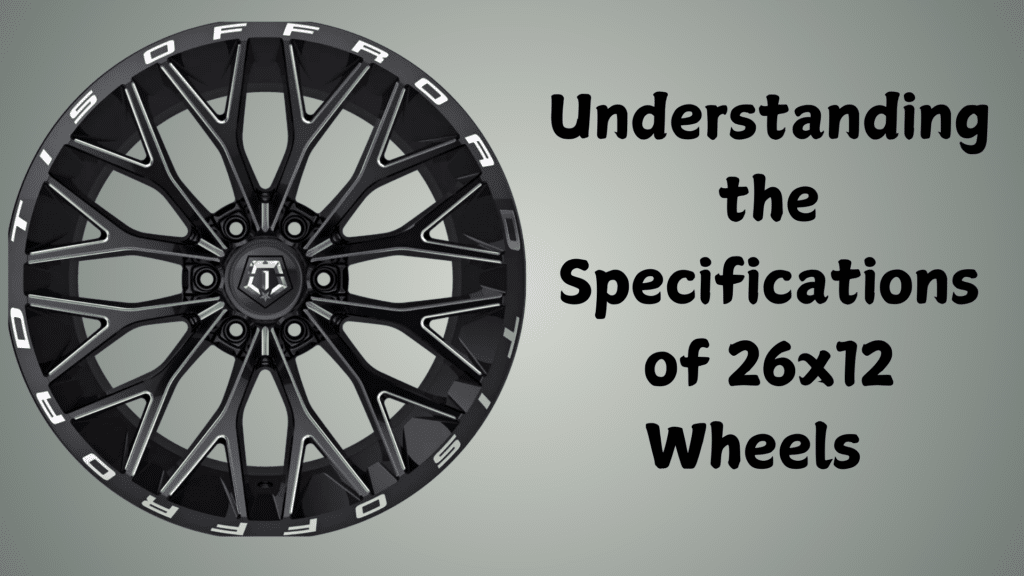Ever wondered what those numbers “26×12” mean on your wheels? You’re not alone. These measurements might seem like just numbers, but they’re crucial for your vehicle’s performance and safety.
Whether you’re looking to replace your wheels or just want to understand your current setup better, knowing about 26×12 wheels will save you time, money, and headaches down the road.
As someone who’s worked with wheels for over a decade, I’ll break down everything you need to know in clear, simple terms.
In this guide, we’ll explore what these numbers actually mean, which vehicles commonly use 26×12 wheels, and how to make sure you get the right fit for your ride.
I’ll also cover maintenance tips and common compatibility issues to watch out for. By the end of this article, you’ll understand exactly what to look for when dealing with 26×12 wheels.
No complex jargon – just straightforward information to help you make smart decisions about your wheels.
Understanding the 26×12 Wheels

What do those numbers in “26×12” actually mean? The 26 tells you the wheel’s diameter in inches – that’s the distance across the wheel from one edge to the other.
The 12 shows you how wide the wheel is, also in inches. Think of it like measuring a pizza – 26 inches across and 12 inches wide.
The key specs you need to know:
- The total diameter (26 inches) includes the wheel’s metal part and leaves room for your tire
- The width (12 inches) is what you see when looking at your wheel from the front
- Most 26×12 wheels have a bolt pattern of either 5 or 6 lugs
- These wheels typically need a backspacing of 4 to 5 inches for proper fit
Common Applications
You’ll mostly find 26×12 wheels on larger vehicles that need extra stability and grip. I’ve seen them work great on:
Lifted trucks use these wheels because they provide better stability on rough terrain. Your Jeep Wrangler or Ford F-150 can handle them well, especially if you’ve modified the suspension.
They’re also popular on custom show trucks where looks matter as much as function.
But here’s something important – before getting 26×12 wheels, you’ll need to check your:
- Wheel well clearance
- Suspension setup
- Fender clearance
- Turning radius requirements
Some vehicles might need modifications to fit these wheels properly. Trust me, it’s better to know this before making the purchase than to deal with rubbing issues later.
Features to Look for in 26×12 Wheels
Material Composition
When you’re looking at 26×12 wheels, the material makes a huge difference in how they perform. Most wheels you’ll find are made from either aluminum alloy or steel.
I’ve worked with both, and What you should know is that aluminum alloy wheels are lighter and won’t rust, making them perfect if you want better fuel economy and handling.
They’re also easier to clean and maintain. Steel wheels, on the other hand, are tougher and can take more abuse, but they’ll add extra weight to your ride.
Design and Aesthetics
Your wheels aren’t just functional – they’re a big part of your vehicle’s look. The great thing about 26×12 wheels is the variety of styles available.
You’ll find everything from classic spoke designs to modern mesh patterns. Many wheels come with a machined finish that creates a two-tone effect, while others might have a full chrome or matte black coating.
I always tell people to consider their vehicle’s overall style – a lifted truck might look best with aggressive spoke patterns, while a show truck could shine with intricate detailed designs.
Load Capacity
This is where safety meets performance, and it’s not something you want to overlook. Most 26×12 wheels are built for heavy-duty use, but they’re not all created equal.
The load capacity depends on two main things: the wheel’s construction and the number of load-bearing points.
Cast wheels typically support weights between 2,500 to 3,500 pounds per wheel, while forged wheels can handle even more.
You’ll need to match this with your vehicle’s weight and how you plan to use it.
If you’re hauling heavy loads or doing serious off-roading, going with a higher load capacity gives you that extra peace of mind.
Remember to check the weight rating stamped on the wheel itself – this tells you exactly what it can handle. Going over this limit isn’t just risky; it could lead to wheel failure when you least expect it.
Popular Vehicle Models That Use 26×12 Wheels
When it comes to fitting 26×12 wheels, not every vehicle can handle these dimensions right out of the box. Here’s a detailed breakdown of common vehicles that work well with these wheels:
| Vehicle Make | Vehicle Model | Compatibility Notes |
|---|---|---|
| Ford | F-250/F-350 | Works best with a 2-inch lift; may need fender trimming |
| Chevrolet | Silverado 2500HD | Fits well with the leveling kit. there minimal rubbing |
| GMC | Sierra 2500 | Compatible with suspension modifications |
| Dodge | RAM 2500/3500 | Perfect fit with the 4-inch lift kit |
| Toyota | Tundra | Requires wheel well modifications |
| Jeep | Gladiator | Needs a lift kit and Fender flares |
| Nissan | Titan XD | Works with 3-inch lift; may need spacers |
| Ford | Bronco | Requires significant modification |
| GMC | Yukon | Compatible with suspension upgrades |
| Ram | 1500 TRX | Minimal modifications needed |
| Chevrolet | Tahoe | Requires lift kit and Fender modifications |
| Jeep | Wrangler JK/JL | Works with proper lift and offset |
Keep in mind that even if your vehicle is listed here, you might still need:
- Proper suspension modifications
- Correct wheel offset
- Appropriate tire size
- Possibly fender modifications
Benefits of Upgrading to 26×12 Wheels
Enhanced Aesthetics
Upgrading to 26×12 wheels makes your vehicle stand out from the crowd. These wheels dramatically change your ride’s profile, giving it that head-turning presence on the road.
The larger diameter creates a bold stance, while the 12-inch width adds a muscular look that’s hard to miss.
I’ve seen how these wheels can transform an ordinary truck into something that commands attention, especially when paired with the right tire setup and vehicle height.
Improved Off-Road Performance
When it comes to tackling tough terrain, 26×12 wheels can seriously up your game. The wider footprint gives you better stability when you’re crawling over rocks or pushing through mud.
Your vehicle gets improved traction because these wheels can handle wider tires with more aggressive tread patterns.
Based on my experience, you’ll notice better grip on loose surfaces and more confidence when taking corners off-road. Plus, the larger diameter helps you clear obstacles more easily.
Increased Resale Value
Something many people don’t consider – quality 26×12 wheels can actually boost your vehicle’s resale value. While not every modification adds value, well-chosen wheels from respected brands can make your vehicle more attractive to potential buyers.
Just keep all your original wheels and parts. I’ve seen trucks with premium 26×12 wheel setups sell faster and command better prices, especially in markets where custom vehicles are popular.
But remember – this only works if you choose quality wheels and install them properly.
Remember though – while these benefits are significant, you’ll need to balance them against your specific needs and vehicle setup.
The best upgrade is one that matches both your style preferences and practical requirements.
Comparing 26×12 Wheels to Other Sizes
Before diving into the comparison table, let me explain what these differences mean for your ride.
Each wheel size offers unique benefits and trade-offs that affect both performance and looks.
| Size | Performance Characteristics | Aesthetic Impact | Best For | Price Range |
|---|---|---|---|---|
| 20×10 | Better fuel economy Smoother highway ride quicker acceleration | Subtle, sporty look | Daily driving, light offroad | $200400 per wheel |
| 22×12 | Good balance of on/offroad Improved stability Moderate fuel impact | Bold, modern appearance | Mixed-use, show trucks | $300600 per wheel |
| 24×12 | Enhanced ground clearance increased brake clearance Heavier overall weight | Aggressive stance | Custom builds, show vehicles | $400800 per wheel |
| 26×12 | Maximum ground clearance Superior traction Heaviest options impact on fuel economy | Most dominant presence | Serious offroad, custom builds | $5001000+ per wheel |
Key Performance Notes:
- Smaller wheels (20×10) respond faster but offer less ground clearance
- Larger wheels (26×12) provide better stability but affect fuel economy more
- Middle sizes (22×12, 24×12) offer a good compromise for most users
Remember: The right size depends on how you actually use your vehicle, not just how you want it to look.
The right combination of these factors will help ensure your 26×12 wheels fit correctly and perform as intended.
How to Maintain and Care for 26×12 Wheels?

Regular Cleaning Practices
Taking care of your 26×12 wheels isn’t just about keeping them shiny – it’s about making them last. Start with a weekly cleaning routine using the right products.
Always use a pH-neutral wheel cleaner rather than harsh chemicals that can damage the finish. I’ve learned that letting brake dust sit on your wheels can lead to permanent staining and corrosion over time.
My tried-and-true cleaning process: First, rinse the wheels while they’re cool (never clean hot wheels). Use a soft brush to gently scrub the surface, getting into all those nooks and crannies.
Pay special attention to the barrel of the wheel – that’s where most grime builds up. After cleaning, dry them thoroughly with a microfiber towel to prevent water spots.
Inspection for Damage
Make it a habit to check your wheels at least once a month for any signs of damage. Run your hand around the rim to feel for bends or dents.
Look closely at the spokes and mounting points for any hairline cracks – these can be dangerous if left unchecked. Also, watch out for:
- Uneven tire wear (could indicate alignment issues)
- Vibration while driving (possibly bent wheel)
- Slow air leaks (might mean rim damage)
Protective Coatings
Think of wheel sealant as sunscreen for your wheels. A good ceramic coating or wheel sealant creates a protective barrier against brake dust, road grime, and weather.
Apply a fresh coat every 3-4 months, depending on your driving conditions. The right coating will make future cleaning easier and protect your investment for years to come.
If you live where roads are salted in winter or near the coast, consider an extra layer of protection.
A quality wheel wax or ceramic coating is worth the effort – it can prevent oxidation and keep your wheels looking new for much longer.
Tips for Choosing the Right 26×12 Wheels
Assessing Vehicle Compatibility
Before you get excited about a specific set of 26×12 wheels, let’s make sure they’ll actually work with your ride. First, check your vehicle’s bolt pattern – this is non-negotiable and must match exactly.
Next, measure your wheel wells and fender clearance. I always tell people to consider the offset carefully – it determines how your wheels will sit in relation to your fenders. You’ll need to think about:
The wrong offset can cause rubbing, affect your steering, and even damage your suspension. If you’re not sure about measurements, get help from a professional. Trust me, it’s cheaper than buying wheels twice.
Considering Driving Habits
Your daily driving routine should guide your wheel choice. If you’re mostly on highways, lightweight wheels with a good load rating will serve you well.
For off-road enthusiasts, look for:
- Stronger construction (forged is better than cast)
- Proper reinforcement in high-stress areas
- Beadlock capability if you do serious off-roading
- Scratch-resistant finishes for trail use
Budget Considerations
Quality 26×12 wheels aren’t cheap, but that doesn’t mean you need to break the bank. Generally, expect to spend between $300-$1000 per wheel, depending on the brand and construction.
However, the real cost includes:
- Mounting and balancing
- Possible suspension modifications
- New TPMS sensors
- Alignment after installation
Rather than going for the cheapest option, invest in wheels that match your needs and budget. Remember – you’re not just buying looks. you’re investing in safety and performance.
Sometimes spending a bit more upfront saves money in the long run through better durability and fewer issues.
If you’re on a tight budget, consider last year’s models or package deals that include tires.
Just don’t compromise on quality for the sake of saving a few bucks – these wheels will carry you and your passengers down the road.
Conclusion
After working with wheels for many years, I can tell you that 26×12 wheels aren’t just about making your truck look tough – they’re about real performance when you need it.
Whether you’re hauling heavy loads or hitting rough trails, these wheels can handle the job when chosen and installed correctly.
Remember: match your wheels to your vehicle’s specs, consider your driving needs, and don’t skip on quality. Take care of your wheels with regular cleaning and inspections, and they’ll take care of you on the road.
Even if you’re new to the world of custom wheels, don’t feel overwhelmed. Start with the basics – proper fitment, quality materials, and reliable brands.
Get help from a professional if you’re unsure about measurements or installation.
Your perfect set of 26×12 wheels is out there. Take your time, do your research, and make a choice that’ll serve you well for years to come.
Frequently Asked Questions
How Much Do Quality 26×12 Wheels Typically Cost?
A set of four quality 26×12 wheels usually runs between $1,200 to $4,000. The price varies based on material, brand, and construction method.
Forged wheels sit at the higher end, while cast wheels are more budget-friendly. Don’t forget to factor in installation costs and any needed modifications.
What’s the Best Way to Prevent Damage to 26×12 Wheels?
Regular maintenance is your best defense. Clean them weekly, check tire pressure monthly, and inspect for damage often.
Avoid harsh curbs, deep potholes, and aggressive chemical cleaners. If you’re off-roading, consider protective wheel rings. Also, make sure your alignment is always spot-on to prevent uneven wear.
Will 26×12 Wheels Affect My Fuel Economy?
Yes, you’ll notice some impact on fuel economy. The larger size and extra weight mean your engine works harder. Most owners report a 1-3 mpg decrease.
The exact impact depends on your driving style, tire choice, and vehicle type.
How Do I Know if 26×12 Wheels Will Fit My Truck?
Check your vehicle’s bolt pattern, offset requirements, and wheel well clearance. Measure from the fender to the hub center, and consider your suspension setup.
Most trucks need at least a 2-inch lift for proper fitment. When in doubt, consult a wheel specialist.
Can I Install 26×12 Wheels Myself?
While possible, I recommend professional installation. These wheels are heavy and require precise torque settings. You’ll also need specialized equipment for balancing and alignment.
A pro can spot potential fitment issues and ensure everything’s installed safely.


